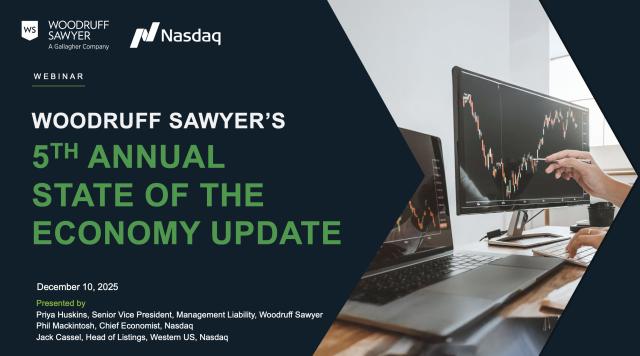Blog
How SPAC Exuberance Led to a Perfect Storm in D&O Insurance
This article first appeared in Bloomberg Law on November 9th, 2020.
2020 has been dubbed “the year of the SPAC” (special purpose acquisition companies) with exponential growth in the number and value of SPACs going public and merging with well-known targets, according to Yelena Dunaevsky, with Woodruff Sawyer. However, the cost of D&O insurance coverage for SPACs jumped this fall and created a perfect storm of eye-popping insurance premium pricing and a constriction in coverage availability and terms.

In October, 49 SPACs (special purpose acquisition companies) priced their IPOs and raised a combined $15.94 billion. By all accounts, 2020 has been the best year for SPACs to date and has been dubbed the year of the SPAC.
The exponential growth in the number and value of SPACs going public and merging with well-known targets like DraftKings in 2020 has drawn attention not only from the financial market participants and investors, but from the media and, most recently, the SEC. SEC’s Chair Jay Clayton generally praised SPACs as a healthy way to create competition in the public market but also raised questions as to whether they are providing sufficient level of disclosure in their registration statements at the time of their IPO and again at their business combination.
One area that has not been well captured in SPAC IPO registration statements is the current pricing around the directors and officers (D&O) insurance coverage available to SPACs.
At the IPO, the SPAC sponsor and management team needs to obtain D&O coverage to protect itself from potential claims and, more importantly, to attract knowledgeable, well-recognized, independent directors.
Leading into October, a typical, mid-size SPAC would opt for between $10 million and $20 million of D&O coverage to be placed at the time of its IPO and most SPAC teams were generally comfortable with that level of coverage. The numbers have changed dramatically over the last four weeks.

Market Demand in D&O Coverage Has Skyrocketed
The tremendous growth in the number of SPACs seeking to go public between September and the end of 2020 has brought the insurance market to a feverish pitch. The market supply has not been able to catch up with the exponentially increasing demand for D&O coverage, creating a perfect storm that is leading to eye-popping insurance premium pricing and a serious constriction in coverage availability and terms.
From the insurer side, several factors are contributing to the difficult situation. First is the sheer number of SPACs that need D&O coverage, which has considerably slowed the insurance placement process as insurers are scrambling to sift through the ever-growing number of submissions.
Second is the limited number of insurers that are willing to write D&O coverage for SPACs; there are only about five or six insurers in the market that are currently able to do so.
Third is the diminishing insurer capacity leading into year-end, which capacity is quickly running out and will not be replenished until January of 2021.
Fourth is that the ever-increasing number of SPACs is attracting additional risk of potential lawsuits and resulting claims, which is making the insurers even more cautious in offering coverage and driving them to increase premium pricing to cover that additional risk. SEC’s recent comments about potential holes in disclosure are also not helping.
Factors Insurers Examine to Determine Pricing
Typically, insurers consider the following factors in deciding premium pricing and terms for a SPAC IPO D&O policy:
- whether the SPAC sponsor team has experienced SPACers or first-time SPACers;
- whether the SPAC team has deep experience in the industry of the target company it plans to acquire;
- the jurisdiction of the SPAC entity and the potential target; and
- the size of the IPO.
Premiums are higher for more inexperienced management teams, for teams that have limited expertise in their proposed target industries, for SPACs and potential targets that are based outside of the US, and for larger IPO raises.
But the situation out in the market right now is such that although insurers are still carefully examining the disclosure in the SPACs’ Form S-1s, they are largely basing their quotes on pure demand.
Current Pricing Is Extreme
This demand has driven SPAC D&O pricing to quadruple over just the last few weeks. As a result, the cost of a $20 million D&O policy has jumped from roughly $400,000 in August, $550,00 in September, to roughly $1.5 million in October.
Not surprisingly, SPAC sponsor teams, who have a limited amount of funds to spend on SPAC operations, are balking at these numbers and are forced to settle in some cases for $5 million in coverage with $5 million in retention (aka deductible) as opposed to $20 million in coverage with $1.5 million in retention they were expecting to obtain.
SPACs that reached out to insurance brokers later in their IPO process are having to deal with the possibility of having to postpone their IPO not only because of the difficult financial market but also because they have to wait longer to get the insurance coverage they need, because they have to have difficult conversations with their boards about smaller coverage limits, and because they now have to raise hundreds of thousands of dollars in unplanned additional expenditures.
To get the best possible pricing and terms, SPACs that are in the market for D&O insurance need to reach out to an insurance broker that specializes in SPAC IPO D&O placements as soon as they have a draft of their Form S-1 ready.
Outlook for 2021
Although the situation right now is dire, there are calmer waters on the horizon. The insurance market is going to continue to be severely constricted through the end of
2020, but come 2021 we are likely to see additional insurance capacity, some reduction in the number of SPAC IPOs as SPAC exuberance settles down, and potential appetite for coverage from carriers who are not currently in the SPAC D&O market or who are currently only offering excess coverage.
These factors will likely ease the current level of stress on the market, but SPAC D&O premium pricing is likely to remain elevated well into 2021.
Visit our SPACs industries page for more insights and resources related to Special Purpose Acquisition Companies.
Author
Table of Contents













